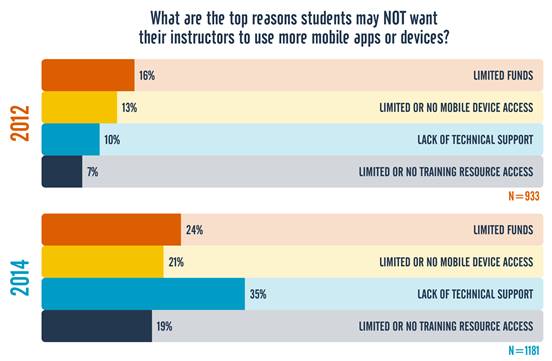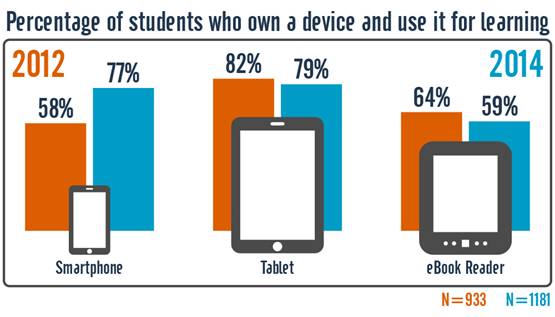Apr
2018
mobile use by students
Students’ Mobile Learning Practices in Higher Education: A Multi-Year Study


++++++++++++++
more about mobile use in this IMS blog
https://blog.stcloudstate.edu/ims?s=mobile+use
Digital Literacy for St. Cloud State University


++++++++++++++
more about mobile use in this IMS blog
https://blog.stcloudstate.edu/ims?s=mobile+use
Today’s vocast will be broadcasted live at:
Adobe Connect | Facebook Live | Twitter (#IMSvodcast) |
and will be archived at:
SCSU MediaSpace | YouTube (subscribe for the channel for future conversations)
Constructivism.
Student-centered learning theory and practice are based on the constructivist learning theory that emphasizes the learner’s critical role in constructing meaning from new information and prior experience.
+++++++++++++++
https://blog.stcloudstate.edu/ims/2018/02/12/first-ims-podcast-on-technology-in-education/
https://www.conferences-scientific.cz/inpage/conference-vienna-iacgetl-2017/
Conference Program Dates
Friday – Saturday, November 24 – 25, 2017
Venue Hotel – Fourside Hotel City Center Vienna
Grieshofgasse 11, A – 1120 Wien / Vienna, AUSTRIA
About the Conference
International Academic Conference in Vienna 2017 is an important international gathering of scholars, educators and PhD students. IAC-GETL 2017 in Vienna will take place in conference facilities located in Vienna, the touristic, business and historic center of Austria.
Conference language: English language
Conferences organized by the Czech Institute of Academic Education z.s. and Czech Technical University in Prague.
Conference Topics – Education, Teaching, Learning and E-learning
Education, Teaching and Learning
Distance Education, Higher Education, Effective Teaching Pedagogies, Learning Styles and Learning Outcomes, Emerging Technologies, Educational Management, Engineering and Sciences Research, Competitive Skills, Continuing Education, Transferring Disciplines, Imaginative Education, Language Education, Geographical Education, Health Education, Home Education, Science Education, Secondary Education, Second life Educators, Social Studies Education, Special Education, Learning / Teaching Methodologies and Assessment, Assessment Software Tools, Global Issues In Education and Research, Education, Research and Globalization, Barriers to Learning (ethnicity, age, psychosocial factors, …), Women and Minorities in Science and Technology, Indigenous and Diversity Issues, Intellectual Property Rights and Plagiarism, Pedagogy, Teacher Education, Cross-disciplinary areas of Education, Educational Psychology, Education practice trends and issues, Indigenous Education, Academic Research Projects, Research on Technology in Education, Research Centres, Links between Education and Research, Erasmus and Exchange experiences in universities, Students and Teaching staff Exchange programmes
E-learning
Educational Technology, Educational Games and Software, ICT Education, E-Learning, Internet technologies, Accessibility to Disabled Users, Animation, 3D, and Web 3D Applications, Mobile Applications and Learning (M-learning), Virtual Learning Environments, Videos for Learning and Educational Multimedia, Web 2.0, Social Networking and Blogs, Wireless Applications, New Trends And Experiences, Other Areas of Education
By Richard Chang 06/21/17
some of the findings in Kahoot!’s first-ever EdTrends Report :
Google is gaining a stronghold in United States classrooms, with Chrome OS expanding its presence on school computers, while Apple’s iOS has been on the decline since the first quarter of 2015 among students and teachers.
Chromebook had the highest number of users among teachers (44 percent) and students (46 percent), when they were asked about their top devices used. Google’s Productivity Suite (G Suite or Classroom) was the most widely used productivity suite in U.S. classrooms, with 57 percent saying they used it, compared to 23 percent saying they used Microsoft Office 365.
a majority of educators (more than 60 percent) said the purpose of adopting education technology was to increase student productivity and efficiency. Their key educational priorities for 2017-18 are “to improve student learning and outcomes” (88 percent), and to “better leverage available time and motivate students” (71 percent).
Educators saw the top ed tech trends in the next school year as:
Some other key findings in the report include:
The complete report can be read on the Kahoot! website here. Kahoot! will be at the International Society for Technology in Education (ISTE) conference
+++++++++++++++++++++++++++++
By Sri Ravipati 06/19/17
Milwaukee Public Schools (MPS), will be receiving some tech handouts from Sprint for the 2017-2018 school year. As part of the company’s 1Million Project — which aims to deliver high-speed internet access to 1 million high school students nationwide — more than 2,500 students at 25 MPS high schools will each receive either a hotspot device, tablet or smartphone.
MPS students will be receiving devices that come with 3GB of high-speed LTE data (with unlimited data available at 2G speeds if usage exceeds that amount). Students can keep their device up to four years while they are in high school no cost, according to initiative site. Additionally, devices are equipped with filters to block adult content that cannot be disabled and are Free Children’s Internet Protection Act (CIPA) compliant.
++++++++++++++
more about mobile devices in education in this IMS blog
https://blog.stcloudstate.edu/ims?s=mobile+devices
By Richard Chang 04/04/17
Mobile learning is the top priority for K–12 IT leaders, according to the fifth annual K–12 IT Leadership Survey published by the Consortium for School Networking (CoSN).
It’s the first time mobile learning ranked as the highest priority in the survey. The No. 2 priority is broadband and network capacity, which ranked first last year, and the No. 3 priority is cybersecurity and privacy, with 62 percent of respondents rating them more important than last year.
CoSN is a nonprofit association for school system technology leaders. To read or download the full IT leadership survey, visit this CoSN site.
+++++++++++++++++++
more on mobile learning in this IMS blog
https://blog.stcloudstate.edu/ims?s=mobile+learning
Wednesday, November 09, 2016 | 02:00 PM EST // 11:00 AM PDT
explore the use and management of mobile devices at schools. Whether your school offers school-issued, BYOD or a combination of both device ownerships
++++++++++++
more on BYOD in education in this IMS blog:
https://blog.stcloudstate.edu/ims?s=byod
The International Journal of Mobile and Blended Learning (IJMBL) provides a forum for researchers in this field to share their knowledge and experience of combining e-learning and m-learning with other educational resources. Providing researchers, practitioners, and academicians with insight into a wide range of topics such as knowledge sharing, mobile games for learning, collaborative learning, and e-learning, this journal contains useful articles for those seeking to learn, analyze, improve, and apply technologies in mobile and blended learning. The journal spans theoretical, technical, and pedagogical issues in mobile and blended learning. These embrace comprehensive or critical reviews of the current literature, relevant technologies and applications, and important contextual issues such as privacy, security, adaptivity, and resource constraints.
The primary mission of the International Journal of Mobile and Blended Learning (IJMBL) is to provide comprehensive coverage and understanding of the role of innovative learning theory and practice in an increasingly mobile and pervasive technological environment. As technology enables a more seamless experience of device supported learning worlds that may integrate mobile, embedded, augmented, and immersive technologies, we may expect to see increasing interest and activity in blended approaches to learning. IJMBL brings together researchers at the forefront of this field, in both technology and pedagogical practice and assists them in the development and dissemination of new approaches to both mobile and blended learning.
+++++++++++++++++++++
More on mobile and blended learning in this IMS blog:
https://blog.stcloudstate.edu/ims?s=mobile+learning
https://blog.stcloudstate.edu/ims?s=blended+learning
New book: Implementing Mobile Language Learning Technologies in Japan
by Steve McCarty, Hiroyuki Obari, and Takeshi Sato
Publisher: Springer Singapore / SpringerBriefs in Education (107 pages)
Table of Contents
Chapter 1 Introduction: Contextualizing Mobile Language Learning in Japan
Chapter 2 Mobile Language Learning Pedagogy: A Sociocultural Perspective
Chapter 3 Tokyo University of Agriculture and Technology Case Study:
Smartphone App LINE for EFL Peer Learning
Chapter 4 Osaka Jogakuin University Case Study:
Mobilizing the EFL Curriculum and Campus Infrastructure with iPods and iPads
Chapter 5 Aoyama Gakuin University Case Study:
Blended Learning and Flipped Classrooms utilizing Mobile Devices
Chapter 6 Conclusion: Implementing Language Learning in a Mobile-Oriented Society
Abstract
This book explores theoretical and practical aspects of implementing mobile language learning in university classrooms for English as a Foreign Language in Japan. The technologies utilized, such as smartphones, iPads, and wi-fi, integrate students’ hand-held devices into the campus network infrastructure. The pedagogical aims of ubiquitous mobile learning further incorporate social media, blended learning, and flipped classroom approaches into the curriculum. Chapter 1 defines mobile language learning within dimensions of e-learning and technology-assisted language learning, prior to tracing the development of mobile learning in Japan. Chapter 2 documents the sociocultural theory underpinning the authors’ humanistic approach to implementation of mobile technologies. The sociocultural pedagogy represents a global consensus of leading educators that also recognizes the agency of Asian learners and brings out their capability for autonomous learning. Case studies of universities, large and small, public and private, are organized similarly in Chapters 3 to 5. Institutional/pedagogical and technological context sections are followed by detailed content on the implementation of initiatives, assessment of effectiveness, and recommendations for other institutions. Distinct from a collection of papers, this monograph tells a story in brief book length about theorizing and realizing mobile language learning, describing pioneering and original initiatives of importance to practitioners in other educational contexts.
Authors
Steve McCarty lectures for Kansai University, Osaka Jogakuin University, KIC Graduate School of IT, and the government agency JICA.
Hiroyuki Obari, PhD in Computer Science, is a Professor at the Aoyama Gakuin University College of Economics in Tokyo.
Takeshi Sato is an Associate Professor at the Division of Language and Culture Studies, Tokyo University of Agriculture and Technology.
Ordering information from Springer
Paperback (ISBN: 978-981-10-2449-8):
http://www.springer.com/us/book/9789811024498
eBook (ISBN: 978-981-10-2451-1) or individual chapters:
http://link.springer.com/book/10.1007/978-981-10-2451-1
++++++++++++++++++++++
more on mobile technologies in this IMS blog
https://blog.stcloudstate.edu/ims?s=mobile+devices
Title: Mobile Device Management – Strategies for Success
Date: Wed. 11/09 | 02:00 PM EST // 11:00 AM PDT
Register now
++++++++++++++
more on BYOD in education in this IMS blog
https://blog.stcloudstate.edu/ims?s=byod
https://thejournal.com/Articles/2016/10/11/How-Teachers-Leverage-Mobile-Technology.aspx
“Teachers and administrators continue to see the No. 1 benefit of any digital tool, content or resource as enhancing student engagement. While that is interesting, it has limited value. Lots of thing can engage kids — that does not necessarily point to an academic benefit or value proposition on its own. So, I always acknowledge the engagement benefit but look deeper at other benefits that can shed new insights into how the teachers are leveraging these powerful devices to transform education — or to change the trajectory of the learning process for their students.
among the more interesting or meaningful benefits were:
++++++++++++++++++++
more on mobile technology in this blog
https://blog.stcloudstate.edu/ims?s=mobile+technology